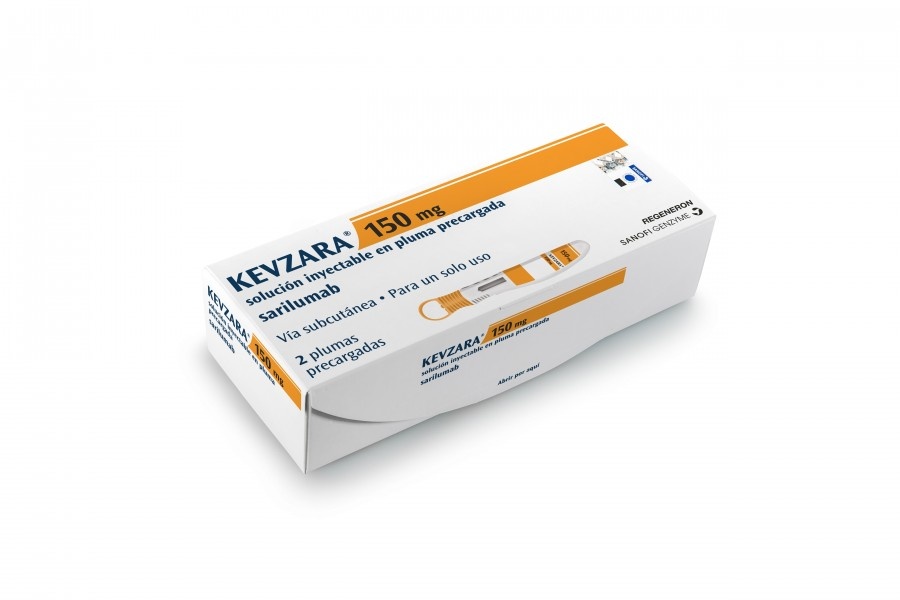
How to use KEVZARA 150 mg SOLUTION FOR INJECTION IN PRE-FILLED SYRINGE
Introduction
Package Leaflet: Information for the Patient
Kevzara 150 mg Solution for Injection in Pre-filled Syringe
Kevzara 200 mg Solution for Injection in Pre-filled Syringe
sarilumab
This medicinal product is subject to additional monitoring, which will allow for the quick detection of new safety information. You can help by reporting any side effects you may get. The last section of the leaflet contains information on how to report side effects.
Read all of this leaflet carefully before you start using this medicine, because it contains important information for you.
- Keep this leaflet, you may need to read it again.
- If you have any further questions, ask your doctor, pharmacist, or nurse.
- This medicine has been prescribed for you only. Do not pass it on to others. It may harm them, even if their signs of illness are the same as yours.
- If you get any side effects, talk to your doctor, pharmacist, or nurse. This includes any possible side effects not listed in this leaflet. See section 4.
In addition to this leaflet, you will be given a patient information card, which contains important safety information that you need to be aware of before and during treatment with Kevzara.
Contents of the Package Leaflet
- What is Kevzara and what is it used for
- What you need to know before you use Kevzara
- How to use Kevzara
- Possible side effects
- Storage of Kevzara
- Contents of the pack and further information
1. What is Kevzara and what is it used for
What is Kevzara
Kevzara contains the active substance sarilumab. It is a type of protein called a monoclonal antibody.
What is Kevzara used for
Kevzara is used to treat adults with moderate to severe active rheumatoid arthritis when previous treatments have not worked well or cannot be tolerated. Kevzara can be used alone or in combination with a medicine called methotrexate.
It may help to:
- slow down joint damage
- improve your ability to perform daily activities.
How Kevzara works
- Kevzara binds to the receptor of another protein called interleukin-6 (IL-6) and blocks its action.
- IL-6 plays a major role in the symptoms of rheumatoid arthritis such as pain, joint inflammation, morning stiffness, and fatigue.
2. What you need to know before you use Kevzara
Do not use Kevzara:
- if you are allergic to sarilumab or any of the other ingredients of this medicine (listed in section 6).
- if you have a severe active infection.
Warnings and precautions
Tell your doctor, pharmacist, or nurse if:
- you have any infection or if you get infections often. Kevzara may reduce your body's ability to fight infection: this means you may be more likely to get infections or make an existing infection worse.
- you have tuberculosis (TB), symptoms of TB (persistent cough, weight loss, lack of appetite, mild fever), or have been in close contact with someone with TB. Before starting treatment with Kevzara, your doctor will do tests for TB.
- you have had viral hepatitis or other liver disease. Before using Kevzara, your doctor will do a blood test to check your liver function.
- you have had diverticulitis (a disease of the colon) or stomach or intestinal ulcers, or develop symptoms such as fever and stomach pain (abdominal pain) that does not go away.
- you have had any type of cancer.
- you have been recently vaccinated or are about to be vaccinated.
If any of the above applies to you (or if you are not sure), consult your doctor, pharmacist, or nurse before using Kevzara.
Blood tests should be done before you receive Kevzara. Blood tests should also be done during your treatment. This is to check if you have a low blood cell count, liver problems, or changes in your cholesterol levels.
Children and adolescents
Kevzara is not recommended for use in children and adolescents below 18 years of age.
Other medicines and Kevzara
Tell your doctor or pharmacist if you are using, have recently used, or might use any other medicines. This is because Kevzara may affect the way other medicines work. Other medicines may also affect the way Kevzara works.
In particular, do not use Kevzara and tell your doctor or pharmacist if you are using:
- a group of medicines called “Janus kinase (JAK) inhibitors” (used for diseases such as rheumatoid arthritis and cancer)
- other biologic medicines used to treat rheumatoid arthritis
If any of the above applies to you (or if you are not sure), consult your doctor or pharmacist.
Kevzara may affect the way some medicines work: this means that it may be necessary to change the dose of other medicines. If you are using any of the following medicines, tell your doctor or pharmacist before using Kevzara:
- statins, used to lower cholesterol levels
- oral contraceptives
- theophylline, used to treat asthma
- warfarin, used to prevent blood clots
If any of the above applies to you (or if you are not sure), consult your doctor or pharmacist.
Pregnancy and breastfeeding
Talk to your doctor before using Kevzara if you are pregnant, think you may be pregnant, or are planning to have a baby.
- Do not use Kevzara if you are pregnant unless your doctor specifically recommends it.
- The effects of Kevzara on the fetus are not known.
- Your doctor and you must decide if you should receive treatment with Kevzara if you are breastfeeding.
Driving and using machines
Kevzara is not expected to affect your ability to drive or use machines. However, if you feel tired or unwell after receiving treatment with Kevzara, do not drive or use machines.
3. How to use Kevzara
Treatment should be initiated by a doctor with experience in the diagnosis and treatment of rheumatoid arthritis. Follow exactly the instructions for administration of this medicine given by your doctor or pharmacist. If you are not sure, consult your doctor or pharmacist again.
Kevzara is given as an injection under the skin (called a subcutaneous injection).
The recommended dose is one 200 mg injection every two weeks.
- Your doctor may adjust the dose of your medicine based on the results of your blood tests.
Learn how to use the pre-filled syringe
- Your doctor, pharmacist, or nurse will teach you how to inject Kevzara. Following these instructions, Kevzara can be injected by you or administered by a caregiver.
- Follow carefully the “Instructions for Use” included in this package.
- Use the pre-filled syringe exactly as described in the “Instructions for Use”.
If you use more Kevzara than you should
If you have used more Kevzara than you should, tell your doctor, pharmacist, or nurse.
If you forget to use a dose of Kevzara
If it has been 3 days or less since the missed dose:
- inject your missed dose as soon as possible.
- then administer your next dose on the next scheduled day.
If it has been 4 days or more, inject your next dose on the next scheduled day. Do not inject a double dose to make up for the missed dose.
If you are not sure when you should inject your next dose, ask your doctor, pharmacist, or nurse for instructions.
If you stop treatment with Kevzara
Do not stop treatment with Kevzara without talking to your doctor.
If you have any further questions on the use of this medicine, ask your doctor, pharmacist, or nurse.
4. Possible side effects
Like all medicines, this medicine can cause side effects, although not everybody gets them.
Severe side effect
Tell your doctor immediatelyif you think you have an infection(which may affect up to 1 in 10 people). Symptoms may include fever, sweating, or chills.
Other side effects
Tell your doctor, pharmacist, or nurse if you notice any of the following side effects:
Very common(may affect more than 1 in 10 people):
- low white blood cell count according to blood tests
Common(may affect up to 1 in 10 people):
- infections in your nose or throat, congestion or runny nose, and sore throat (upper respiratory tract infection)
- urinary tract infection
- fever blisters (oral herpes)
- low platelet count according to blood tests
- high cholesterol, high triglycerides according to blood tests
- abnormal liver function tests
- reactions at the injection site (including redness and itching)
Uncommon(may affect up to 1 in 100 people):
- lung infection
- inflammation of the deep skin tissue
- diverticulitis (a disease that affects the intestine, often with stomach pain (abdominal pain), nausea, and vomiting, fever, and constipation, or less frequently diarrhea)
Rare(may affect up to 1 in 1,000 people):
- hole in the stomach or intestine (a hole that develops in the wall of the intestine)
Reporting of side effects
If you experience any side effects, talk to your doctor, pharmacist, or nurse, even if it is possible side effects not listed in this leaflet. You can also report side effects directly via the national reporting system listed in Appendix V*. By reporting side effects, you can help provide more information on the safety of this medicine.
5. Storage of Kevzara
Keep this medicine out of the sight and reach of children.
Do not use this medicine after the expiry date which is stated on the label after EXP. The expiry date refers to the last day of the month shown.
Store in a refrigerator (2°C to 8°C).
- Do not freeze or heat the syringe.
- Once removed from the refrigerator, do not store Kevzara above 25°C.
- Write the date you removed the syringe from the refrigerator in the space provided on the outer packaging.
- Use the syringe within 14 days of removing it from the refrigerator or insulated bag.
- Keep the syringe in the original package to protect it from light.
Do not use this medicine if the solution in the syringe is cloudy, discolored, or contains particles, or if any part of the pre-filled syringe appears damaged.
After use, put the syringe in a puncture-resistant container. Keep the container out of the sight and reach of children. Ask your doctor, pharmacist, or nurse how to dispose of the container. Do not recycle the container.
Medicines should not be disposed of via wastewater or household waste. Ask your pharmacist how to dispose of medicines no longer required. This will help protect the environment.
6. Container Contents and Additional Information
Kevzara Composition
- The active ingredient is sarilumab.
- The other excipients are arginine, histidine, polysorbate 20, sucrose, and water for injectable preparations.
Product Appearance and Container Contents
Kevzara is a clear, colorless to pale yellow injectable solution, presented in a pre-filled syringe.
Each pre-filled syringe contains 1.14 ml of solution, providing a single dose. It is available in packs of 1 or 2 pre-filled syringes or in a multipack of 6 pre-filled syringes (3 packs of 2).
Only some pack sizes may be marketed.
Kevzara is available as 150 mg or 200 mg pre-filled syringes.
Marketing Authorization Holder
sanofi-aventis groupe 54, rue La Boétie F-75008 Paris
France
Manufacturer
Sanofi Winthrop Industrie
1051 Boulevard Industriel
76580 Le Trait,
France
You can request more information about this medicinal product by contacting the local representative of the marketing authorization holder:
Belgium/Belgique/Belgien Sanofi Belgium Tel: +32 (0)2 710 54 00 | Lithuania Swixx Biopharma UAB Tel: +370 5 236 91 40 |
Bulgaria Swixx Biopharma EOOD Tel: +359 (0)2 4942 480 | Luxembourg/Luxemburg Sanofi Belgium Tel: +32 (0)2 710 54 00 (Belgique/Belgien) |
Czech Republic sanofi-aventis, s.r.o. Tel: +420 233 086 111 | Hungary SANOFI-AVENTIS Zrt. Tel: +36 1 505 0050 |
Denmark Sanofi A/S Tlf: +45 45 16 70 00 | Malta Sanofi S.r.l. Tel: +39 02 39394275 |
Germany Sanofi-Aventis Deutschland GmbH Telefon: 0800 04 36 996 Telefon from abroad: +49 69 305 70 13 | Netherlands Genzyme Europe B.V. Tel: +31 20 245 4000 |
Estonia Swixx Biopharma OÜ Tel: +372 640 10 30 | Norway sanofi-aventis Norge AS Tlf: +47 67 10 71 00 |
Greece sanofi-aventis AEBE Tel: +30 210 900 16 00 | Austria sanofi-aventis GmbH Tel: +43 1 80 185 – 0 |
Spain sanofi-aventis, S.A. Tel: +34 93 485 94 00 | Poland sanofi-aventis Sp. z o.o. Tel: +48 22 280 00 00 |
France sanofi-aventis france Tel: 0 800 222 555 Call from abroad: +33 1 57 63 23 23 | Portugal Sanofi - Produtos Farmacêuticos, Lda Tel: +351 21 35 89 400 |
Croatia Swixx Biopharma d.o.o. Tel: +385 1 2078 500 | Romania Sanofi Romania SRL Tel: +40 (0) 21 317 31 36 |
Ireland sanofi-aventis Ireland Ltd. T/A SANOFI Tel: +353 (0) 1 403 56 00 | Slovenia Swixx Biopharma d.o.o. Tel: +386 1 235 51 00 |
Iceland Vistor hf. Tel: +354 535 7000 | Slovakia Swixx Biopharma s.r.o. Tel: +421 2 208 33 600 |
Italy Sanofi S.r.l. Tel: 800 13 12 12 (technical questions) 800 536389 (other questions) | Finland Sanofi Oy Tel: +358 (0) 201 200 300 |
Cyprus C.A. Papaellinas Ltd. Tel: +357 22 741741 | Sweden Sanofi AB Tel: +46 (0)8 634 50 00 |
Latvia Swixx Biopharma SIA Tel: +371 6 616 47 50 | United Kingdom Sanofi Tel: +44 (0) 845 372 7101 |
Date of Last Revision of this Leaflet:
Detailed information on this medicinal product is available on the European Medicines Agency website: http://www.ema.europa.eu.
--------------------------------------------------------------------------------------------------------------------
Kevzara 150 mg Solution for Injection in Pre-filled Syringe
sarilumab
Instructions for Use
The parts of the Kevzara pre-filled syringe are shown in this drawing.
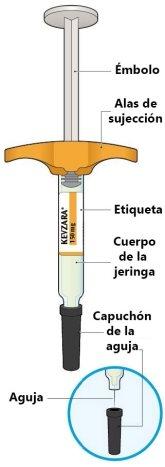
Important Information
This device is a single-dose pre-filled syringe (called a "syringe" in these instructions). It contains 150 mg of Kevzara for subcutaneous injection once every two weeks.
Ask your healthcare professional to show you how to use the syringe correctly before your first injection.
What to Do
- Read all the instructions carefully before using a syringe.
- Check that you have the correct medicine and dose.
- Store unused syringes in the original packaging and keep them in the refrigerator at a temperature between 2°C and 8°C.
- Keep the packaging in a thermal bag with a cold pack when traveling.
- Let the syringe reach room temperature for at least 30 minutes before using it.
- Use the syringe within 14 days of removing it from the refrigerator or thermal bag.
- Keep the syringe out of sight and reach of children.
What Not to Do
Do not use the syringe if it has been damaged or if the needle cap is missing or not attached.
Do not remove the needle cap until you are ready for injection.
- Do not touch the needle.
- Do not try to put the needle cap back on the syringe.
- Do not reuse the syringe.
- Do not freeze or heat the syringe.
- Once removed from the refrigerator, do not store the syringe at a temperature above 25°C.
- Do not expose the syringe to direct sunlight.
- Do not inject through clothing.
If you have any further questions, consult your doctor, pharmacist, or nurse or call the sanofi number indicated in the leaflet.
Step A: Preparation for Injection
- Prepare all the equipment you will need in a clean and flat area.
- You will need an alcohol swab, a cotton ball or gauze, and a sharps container.
- Remove a syringe from the packaging by holding it in the middle of the syringe body. Store the remaining syringe in the packaging in the refrigerator.
- Check the label.
- Make sure you have the correct medicine and dose.
- Check the expiration date (EXP).
- Do notuse the syringe if it is expired.
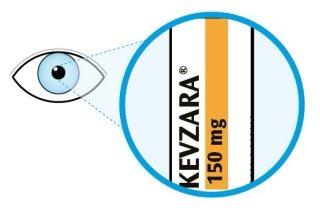
- Check the medicine.
- Make sure the liquid is clear and colorless to pale yellow.
- You may see an air bubble; this is normal.
- Do notproceed with the injection if the liquid is cloudy, discolored, or contains particles.
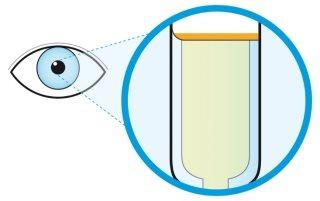
- Place the syringe on a flat surface and let it reach room temperature (<25°C) for at least 30 minutes.
- Using the syringe at room temperature may make the injection more comfortable.
- Do notuse the syringe if it has been out of the refrigerator for more than 14 days.
- Do notheat the syringe; let it warm up naturally.
- Do notexpose the syringe to direct sunlight.
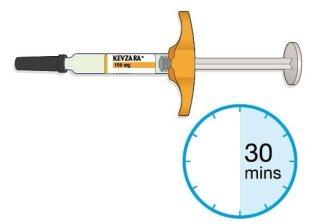
- Choose the injection site.
- You can inject into your thigh or stomach (abdomen) except for the 5 cm around your navel. If someone else is giving you the injection, you can also choose the outer upper arm.
- Change the injection site each time you inject.
- Do notinject into sensitive, damaged, or scarred skin.
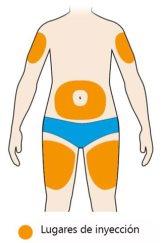
- Prepare the injection site.
- Wash your hands.
- Disinfect the skin with an alcohol swab.
- Do nottouch the injection site again before injecting.
Step B: Perform the Injection– Proceed with Step B only after completing Step A "Preparation for Injection"
- Remove the needle cap.
- Hold the syringe by the middle of the syringe body, pointing away from you.
- Keep your hand away from the plunger.
- Do notremove air bubbles from the syringe.
- Do notremove the cap until you are ready for injection.
- Do notput the cap back on the needle.
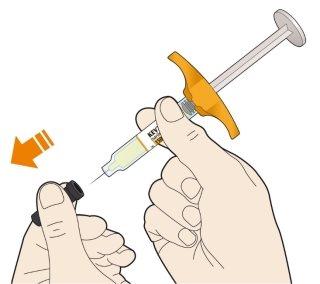
- Pinch the skin.
- Use your thumb and index finger to pinch a fold of skin at the injection site.
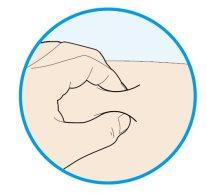
- Insert the needle into the skin fold at an angle of approximately 45°.
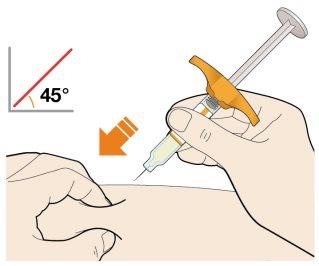
- Push the plunger down.
- Push the plunger slowly until it stops and the syringe is empty.
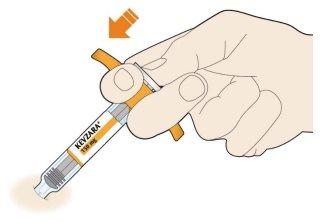
- Before removing the needle, check that the syringe is empty.
- Remove the needle at the same angle as the injection.
- If you see any blood, press the injection site with a cotton ball or gauze.
- Do notrub the skin after injecting.
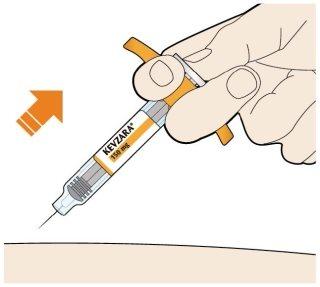
- Put the used syringe and cap into a sharps container immediately after use.
- Always keep the container out of sight and reach of children.
- Do notput the cap back on the needle.
- Do notthrow the used syringe away.
- Do notrecycle the used sharps container.
- Do notthrow the used sharps container away unless local regulations allow it. Ask your doctor, pharmacist, or nurse how to dispose of the container.
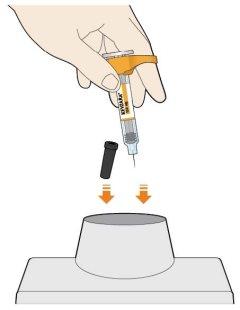
- Country of registration
- Active substance
- Prescription requiredYes
- Manufacturer
- This information is for reference only and does not constitute medical advice. Always consult a licensed doctor before taking any medication. Oladoctor is not responsible for medical decisions based on this content.
- Alternatives to KEVZARA 150 mg SOLUTION FOR INJECTION IN PRE-FILLED SYRINGEDosage form: INJECTABLE, 150 mgActive substance: sarilumabManufacturer: Sanofi Winthrop IndustriePrescription requiredDosage form: INJECTABLE, 200 mgActive substance: sarilumabManufacturer: Sanofi Winthrop IndustriePrescription requiredDosage form: INJECTABLE, 200 mgActive substance: sarilumabManufacturer: Sanofi Winthrop IndustriePrescription required
Online doctors for KEVZARA 150 mg SOLUTION FOR INJECTION IN PRE-FILLED SYRINGE
Discuss dosage, side effects, interactions, contraindications, and prescription renewal for KEVZARA 150 mg SOLUTION FOR INJECTION IN PRE-FILLED SYRINGE – subject to medical assessment and local rules.



